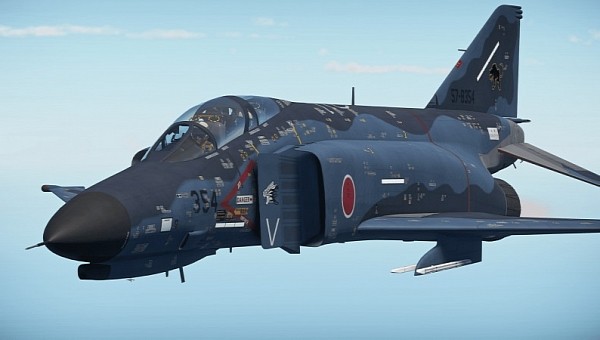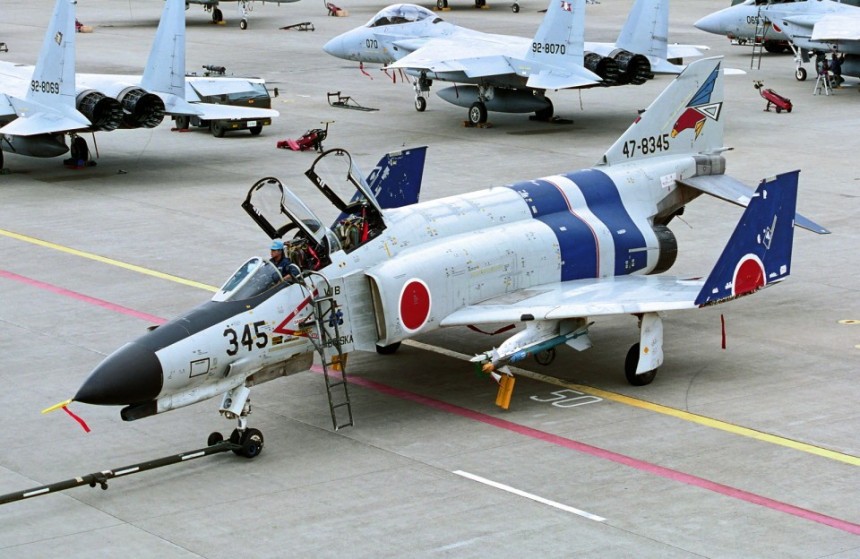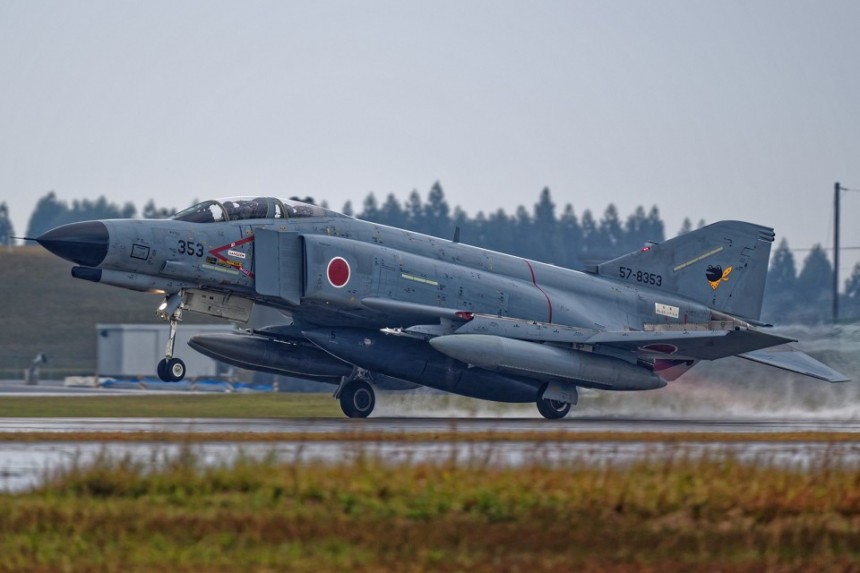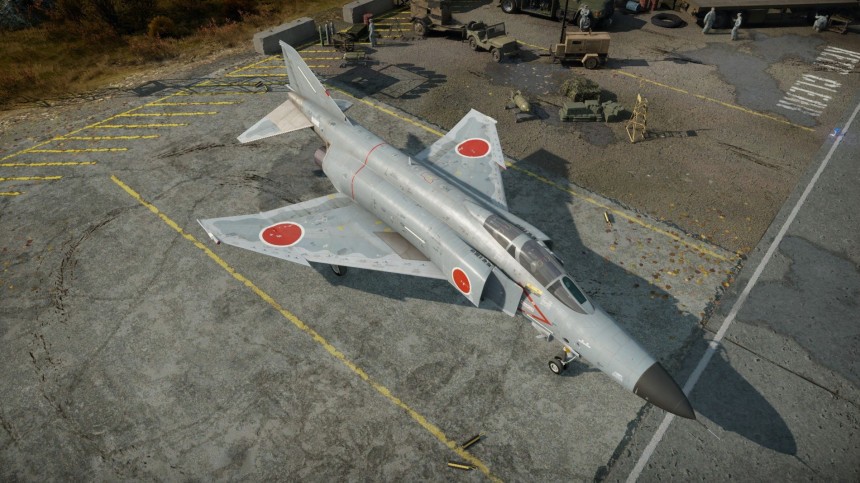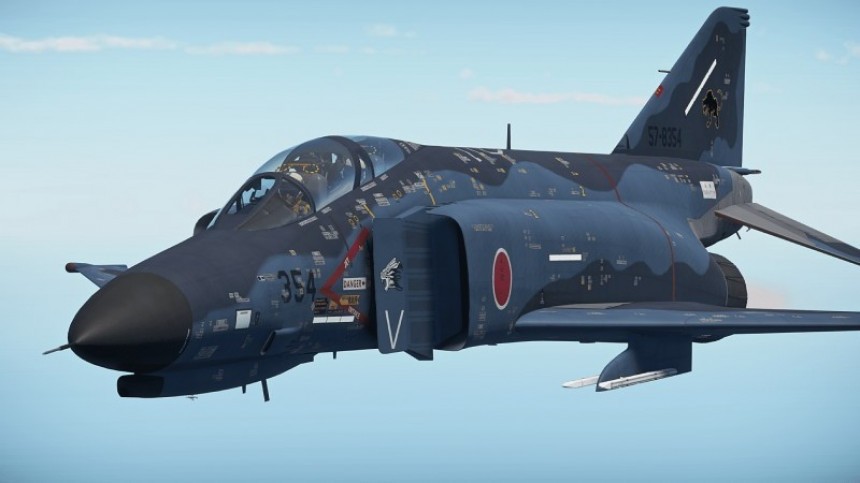If you're of a certain age, you can't help but draw parallels between the real world and our favorite anime. It helps when you're talking about a jet fighter developed by the Americans before the Japanese got their hands on them. They then took an already capable fighter and turned it into something even more spectacular. What resulted was the R34 Nissan GTR of the skies. It's the Mitsubishi F-4EJ Kai.
The F-4EJ and its greatest variant, the EJ Kai, aren't hard to draw parallels between themselves and our favorite anime heroes. From on perspective, the earliest American variants with their feeble radars and no cannon are kind of like a Pichu in Pokémon. The Japanese F-4EJ was therefore like the evolution into Pikachu. But the F-4EJ Kai? That was like the full Raichu, the American McDonnell-Douglas F-4 Phantom II's ultimate evolution.
An airframe so "juiced" up to the gills with upgraded hardware that it wouldn't be entirely useless in many modern combat applications. The F-4EJ's story of one rooted in Japan's post-Second World War renaissance that birthed the JDM car market, Japan's rise to an industrial superpower, and, of course, the gift to god's creation that is Shonen anime.
It was only in the 1960s, close to 25 years after Imperial Japan's capitulation to the Allied Powers, that the Americans deemed the Japanese Self-Defense Force worthy of fielding contemporary fighters for their shared cooperation with affairs in Asia. With fighters including the Phantom II and the Lockheed F-104J Starfighter, Japan suddenly fielded an Air Force as modern as it was swift in its implementation.
The first American F-4Es were acquired from U.S. reserves and shipped to Japan in 1968. By this point, the aircraft had already established itself as the fastest, most capable fighter bomber in the American arsenal. That's despite its numerous flaws in the beginning. You know, like not sporting a cannon at a time when radar-guided and infrared missiles were about as reliable as a mid-70's Chevrolet.
These issues were sorted in due time. By the coming of the dog days of the Vietnam War, the platform had worked out many of the flaws that made the Phantom II fall prey to MiG-17s, 19s, and 21's over the skies of North Hanoi, MiG Alley, and elsewhere. It'd also broken just about every record for speed and altitude for an operational jet fighter, as many as 15 records in total. Even in 2023, only a handful of jets can outrun a Phantom II.
Powered by twin General Electric J-79 engines, the Phantom II was like two F-104s strapped together. In both ground-based Air Force and sea bound Navy and Marine units, the handbook for how to operate Phantoms was known around the world. Apart from the Eastern Bloc, of course. Everywhere else in the world, including Japan, Australia, Israel, Turkey, Greece, South Korea, Spain, Iran, and the U.K., all flew the Phantom II with distinction.
So imagine what happens when this airframe is given to Mitsubishi Motor's sister company, Mitsubishi Heavy Industries, to improve even further. If your answer was a twin-turbo Supra in the skies, you'd be correct. Both J79 engines and their 17,845 lbs (79.38 kN) of thrust each are still present as ever in the Japanese F-4EJs.
The basic F-4EJ can essentially be considered an excellent reproduction of American F-4E variants. Mitsubishi built as many as 138, all capable of handling American weapons like Sparrows, Sidewinders, and even the new Martin Marietta AMG-12 Bullpup air-to-ground missile. That's on top of all the bombs of many sizes, unguided rockets, napalm canisters, and of course, its JM61-A1 20 mm autocannon.
It wasn't until the Mitsubishi F-4EJ Kai that things started to get crazy. Make any anime hero parallel you like. Tailed Beast-form Naruto, Super Saiyan Goku, or All Might about to smack you with the United States of Smash, they all applied to the Phantom EJ Kai. It all started with a radar suite upgrade you might not expect.
If the Westinghouse AN/APG-66 pulse-Doppler radar doesn't ring a bell, the aircraft it's most famously mounted inside sure will. That's right, this Brutish, hulking, Japanese-American brick was fitted with the same radar as the F-16A Fighting Falcon half its size. Knowing this, you can suddenly understand the idea of fielding a 130-or-so-strong fleet of these juiced-up Phantoms.
With all this speed and rate-of-climb domination, the fact the Phantom can still be present on a battlefield 30 to 40 years after Vietnam is nothing short of spectacular. The Phantom EJ Kai was a very effective deterrent from threats like Russia, China, and North Korea from daring to trifle with Japan once again. Against Chinese J-11s, Russian Su-37s, and North Korean MiG-29s, aggressing Air Forces would get all the hell they could handle from Japanese EJ Kais.
Some Phantom II variants, particularly from Germany, Turkey, or Israel, may have been lighter and more maneuverable than the Japanese EJ Kais. But no other variant of the type had quite the same wombo-combo of speed, ordinance variety, and powerful radar which Japanese Kais flew with until their retirement in 2021. But even today, the EJ Kai is one of the most desirable premium aircraft in all of War Thunder.
Released in September 2021 as part of the "Direct Hit" update for Gaijin's free-to-play vehicle combat game, the EJ Kai and its wicked-looking ADTW counterpart are a real gem. Decked out in similar markings to the type's service with the 306th and 301st Tactical Fighter Squadrons, the ADTW's black paint job especially looks absolutely mean.
With Aim-9E and P-series Sidewinders, AIM 7D and E-series Sparrows, Mighty Mouse Rockets, up to 24 Mk-82 500-lb bombs or 45 M177 750-lb bombs, among other fantastic weapons, the EJ Kai and is one of the most fun planes to fly at its battle-rating of 11.0. This places thios EJ Kai frmly in the highest tier number, that being number, VII of all the fighters in the game.
With an asking price of $69.99 for the menacing black-painted EJ ADTW, most argue the price of a brand-new, triple-a-quality video game for a simple DLC add-on is far too much to ask. Especially for a game with an entry cost of buzz-all. This notion might be more or less objectively true. But from another perspective, it makes the F-4EJ like the R-34 Skyline GTR of both War Thunder and the real world.
It's the kind of aircraft that everybody in the world wishes they could fly when all they can afford is a beat-up old Cessna. Those of us with the good fortune of a job that can afford such a luxury can and will wring the necks of our bank accounts for the luxury of flying the "Samurai Phantom." The extra premium time, on top of that, is all just extra gravy.
But the wonderful thing about the F-4 Phantom II, all you'll find, is that it's as adaptable and upgradeable as Air Forces around the world are willing to invest in making it. The Japanese EJ, EJ Kai, and EJ ADTW are just three of dozens of variants of the type among dozens of others from around the world.
It would take hours to list every great variant and upgrade package the Phantom's airframe would accept in over six decades of service since 1958. Of all the great fighter jets in the world, only the Mikoyan-Gurevich MiG-21, the Phantom fought so valiantly, even comes close to that level of longevity. Keep in mind the MiG-21 is still in service around the world as well.
To conclude with one last extra-cheesy, ham-fisted quip about F-4s and anime, the rivalry between itself and the Soviet MiG-21 is a bit like Goku vs. Vegeta, Naruto vs. Sasuke, or Deku vs. Bakugo. One of those GOAT matchups people still talk about long after the Vietnam Evacuation-arc ended on a rather sour note for the Americans. For you non-Shonen fans out there, we have plenty of other airplane profiles without such jokes. But for you weebs among us, you're welcome.
An airframe so "juiced" up to the gills with upgraded hardware that it wouldn't be entirely useless in many modern combat applications. The F-4EJ's story of one rooted in Japan's post-Second World War renaissance that birthed the JDM car market, Japan's rise to an industrial superpower, and, of course, the gift to god's creation that is Shonen anime.
It was only in the 1960s, close to 25 years after Imperial Japan's capitulation to the Allied Powers, that the Americans deemed the Japanese Self-Defense Force worthy of fielding contemporary fighters for their shared cooperation with affairs in Asia. With fighters including the Phantom II and the Lockheed F-104J Starfighter, Japan suddenly fielded an Air Force as modern as it was swift in its implementation.
The first American F-4Es were acquired from U.S. reserves and shipped to Japan in 1968. By this point, the aircraft had already established itself as the fastest, most capable fighter bomber in the American arsenal. That's despite its numerous flaws in the beginning. You know, like not sporting a cannon at a time when radar-guided and infrared missiles were about as reliable as a mid-70's Chevrolet.
Powered by twin General Electric J-79 engines, the Phantom II was like two F-104s strapped together. In both ground-based Air Force and sea bound Navy and Marine units, the handbook for how to operate Phantoms was known around the world. Apart from the Eastern Bloc, of course. Everywhere else in the world, including Japan, Australia, Israel, Turkey, Greece, South Korea, Spain, Iran, and the U.K., all flew the Phantom II with distinction.
So imagine what happens when this airframe is given to Mitsubishi Motor's sister company, Mitsubishi Heavy Industries, to improve even further. If your answer was a twin-turbo Supra in the skies, you'd be correct. Both J79 engines and their 17,845 lbs (79.38 kN) of thrust each are still present as ever in the Japanese F-4EJs.
The basic F-4EJ can essentially be considered an excellent reproduction of American F-4E variants. Mitsubishi built as many as 138, all capable of handling American weapons like Sparrows, Sidewinders, and even the new Martin Marietta AMG-12 Bullpup air-to-ground missile. That's on top of all the bombs of many sizes, unguided rockets, napalm canisters, and of course, its JM61-A1 20 mm autocannon.
If the Westinghouse AN/APG-66 pulse-Doppler radar doesn't ring a bell, the aircraft it's most famously mounted inside sure will. That's right, this Brutish, hulking, Japanese-American brick was fitted with the same radar as the F-16A Fighting Falcon half its size. Knowing this, you can suddenly understand the idea of fielding a 130-or-so-strong fleet of these juiced-up Phantoms.
With all this speed and rate-of-climb domination, the fact the Phantom can still be present on a battlefield 30 to 40 years after Vietnam is nothing short of spectacular. The Phantom EJ Kai was a very effective deterrent from threats like Russia, China, and North Korea from daring to trifle with Japan once again. Against Chinese J-11s, Russian Su-37s, and North Korean MiG-29s, aggressing Air Forces would get all the hell they could handle from Japanese EJ Kais.
Some Phantom II variants, particularly from Germany, Turkey, or Israel, may have been lighter and more maneuverable than the Japanese EJ Kais. But no other variant of the type had quite the same wombo-combo of speed, ordinance variety, and powerful radar which Japanese Kais flew with until their retirement in 2021. But even today, the EJ Kai is one of the most desirable premium aircraft in all of War Thunder.
With Aim-9E and P-series Sidewinders, AIM 7D and E-series Sparrows, Mighty Mouse Rockets, up to 24 Mk-82 500-lb bombs or 45 M177 750-lb bombs, among other fantastic weapons, the EJ Kai and is one of the most fun planes to fly at its battle-rating of 11.0. This places thios EJ Kai frmly in the highest tier number, that being number, VII of all the fighters in the game.
With an asking price of $69.99 for the menacing black-painted EJ ADTW, most argue the price of a brand-new, triple-a-quality video game for a simple DLC add-on is far too much to ask. Especially for a game with an entry cost of buzz-all. This notion might be more or less objectively true. But from another perspective, it makes the F-4EJ like the R-34 Skyline GTR of both War Thunder and the real world.
It's the kind of aircraft that everybody in the world wishes they could fly when all they can afford is a beat-up old Cessna. Those of us with the good fortune of a job that can afford such a luxury can and will wring the necks of our bank accounts for the luxury of flying the "Samurai Phantom." The extra premium time, on top of that, is all just extra gravy.
It would take hours to list every great variant and upgrade package the Phantom's airframe would accept in over six decades of service since 1958. Of all the great fighter jets in the world, only the Mikoyan-Gurevich MiG-21, the Phantom fought so valiantly, even comes close to that level of longevity. Keep in mind the MiG-21 is still in service around the world as well.
To conclude with one last extra-cheesy, ham-fisted quip about F-4s and anime, the rivalry between itself and the Soviet MiG-21 is a bit like Goku vs. Vegeta, Naruto vs. Sasuke, or Deku vs. Bakugo. One of those GOAT matchups people still talk about long after the Vietnam Evacuation-arc ended on a rather sour note for the Americans. For you non-Shonen fans out there, we have plenty of other airplane profiles without such jokes. But for you weebs among us, you're welcome.
